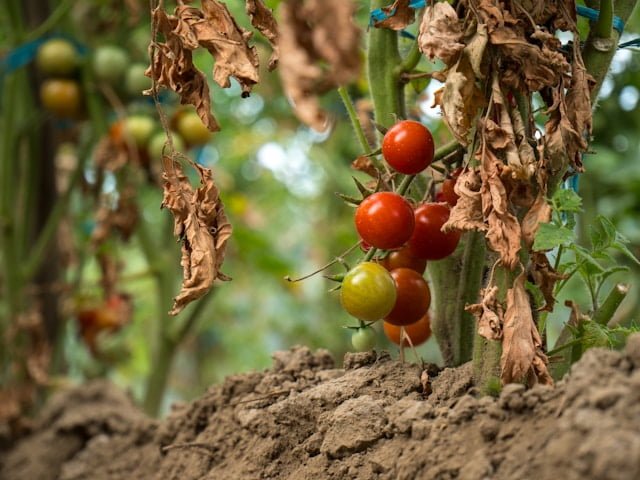Don’t let the sight of tomato plant leaves turning brown dampen your enthusiasm for gardening! This common issue, often called tomato leaves browning, can be managed with the right know-how. Tomato plant leaves turning brown and curling can be a real buzzkill. But fear not, fellow tomato enthusiast! Understanding the causes of browning leaves in tomato plants is the key to getting your plants back on track.
Several culprits could be at play, whether your leaves are turning brown from the bottom up or developing tomato leaves brown spots. Tomato blight, both early and late varieties, is a primary concern, causing significant browning issues.
This guide equips you with the knowledge to tackle these gardening challenges effectively. You’ll gain insights into the common issues and their solutions.
Understanding Tomato Plant Health
Encountering tomato plant leaf discoloration, especially when the leaves start turning brown, can be disheartening for any gardener. But fear not! This guide delves into why my tomato plant leaves turn brown, empowering you to diagnose the problem and take informed action.
The Basics of Tomato Plant Care:
Several factors can trigger this distress signal in your tomato plants. Let’s explore the main culprits behind these gardening woes:
Environmental Stress:
Heat & Drought: Intense heat or prolonged dry spells can dehydrate your plants, often resulting in tomato leaves turning brown on the edges and curling to conserve moisture.
Temperature Fluctuations: Sudden temperature changes can also shock the plant, leading to browning and curling.
Specific Diseases:
Tomato Blight: Fungal infections like early and late blight pose significant threats to your plants. These diseases often manifest as brown spots on tomato leaves that eventually lead to browning and curling. Adopting crop rotation and planting resistant varieties can aid in prevention.
Pest Infestations:
Spider Mites: Tiny sap-sucking insects are another common reason a tomato plant turns brown. Watch for signs of webbing on your plants and manage these pests promptly to prevent further damage.
Nutrient Deficiencies:
Missing Nutrients: Tomato plant brown leaves often signify essential nutrients like potassium, magnesium, or iron being in short supply, leading to discoloration and curling. Regular soil testing paired with proper fertilization can effectively address these deficiencies and prevent the issue of brown leaves in the tomato plant.
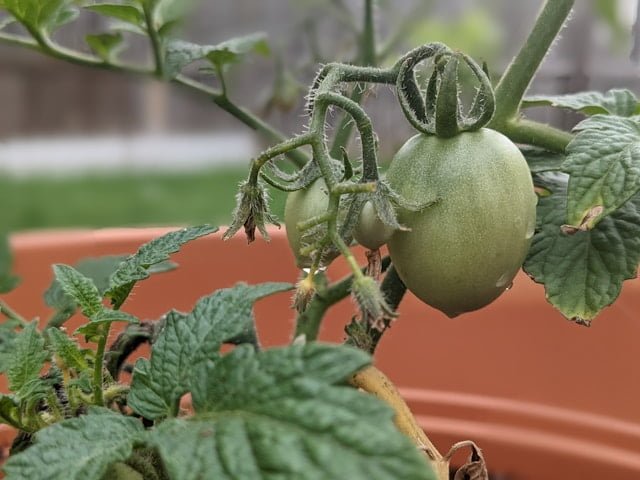
Taking Action:
By identifying these, you can take targeted steps:
· Adjust Watering: Address dehydration with proper watering.
· Disease Management: Implement strategies to prevent or control diseases.
· Pest Control: Manage pest infestations effectively.
· Nutrient Management: Ensure proper nutrient availability through regular testing and fertilization.
Please find details in the Specific Symptoms and Their Solutions Section Below.
Prevention is Key:
Specific measures can significantly mitigate the risk of tomato plants turning brown and experiencing leaf curling. These measures include employing proper planting techniques, regularly monitoring, and fostering optimal growing conditions to keep your tomato plants healthy.
Armed with the proper knowledge, you can tackle the issue of tomato brown leaves effectively, ensuring that your tomato plants survive, thrive, and produce an abundant harvest!
Common Causes of Browning Leaves in Tomato Plants
The sight of brown tomato leaves can be concerning, but there’s no need for alarm. We will explore two prevalent causes of this problem: bacterial leaf spots and fungal blights, often at the root of the browning leaves on tomato plants.
Bacterial and Fungal Infections
Bacterial Leaf Spot:
· Symptoms: Be vigilant for the early signs of brown edges on tomato leaves, such as small, dark brown to black spots encircled by a yellow halo. These spots can proliferate across the foliage, inflicting severe damage and causing leaves to drop prematurely.
· Treatment: When you notice tomato leaves with brown edges, it’s crucial to concentrate on halting the infection’s spread. Remove and properly dispose of infected foliage, and steer clear of overhead watering to avert bacteria-laden splashes. While copper-based bactericides can aid in management, prioritizing prevention is essential.
· Prevention: Start with disease-free seeds and plants to prevent your tomato leaves from turning brown. Implement crop rotation and ensure proper spacing to promote good air circulation. Sanitizing your gardening tools and avoiding garden work when the plants are damp will help minimize the risk of bacterial transmission.
Early and Late Blight:
· Early Blight: The common question of ‘Why are the leaves on my tomato plant turning brown?’ can often be attributed to Alternaria solani, a fungus that manifests as dark, concentric circles on older foliage, which can lead to significant leaf loss and a decline in overall plant vitality.
· Treatment: Implementing cultural practices such as mulching, ensuring proper spacing between plants, and avoiding overhead watering are effective strategies to mitigate spore proliferation and can help address the issue of tomato stems turning brown. In climates prone to warm, humid conditions, the preemptive use of fungicides can serve as a protective measure.
· Late Blight: Tomato plants turning brown from the bottom up may suffer from a more aggressive affliction caused by Phytophthora infestans. This pathogen is characterized by large, dark lesions on leaves and fruits, often accompanied by a white, fuzzy growth on the underside of leaves in moist environments, and has the potential to ravage crops swiftly.
· Treatment & Prevention: To prevent the alarming sight of a tomato plant stem turning brown, it’s essential to employ prevention tactics. Key steps include opting for disease-resistant cultivars, applying fungicides, and maintaining a clean garden to minimize the presence of fungal spores. Consistent, early fungicide application, even before the onset of symptoms, can prove to be a formidable defence.
Remember: Both bacterial and fungal issues benefit from a multi-pronged approach:
· Early Detection: Observe your plants diligently.
· Prompt Action: Address infected plants quickly.
· Prevention Strategies: Implement cultural practices and consider fungicides to shield your garden.
By recognizing the typical reasons for ‘why are my tomato plants turning brown’ and adopting proactive management strategies, gardeners can safeguard their plants, ensuring they flourish and yield an abundant harvest all season.
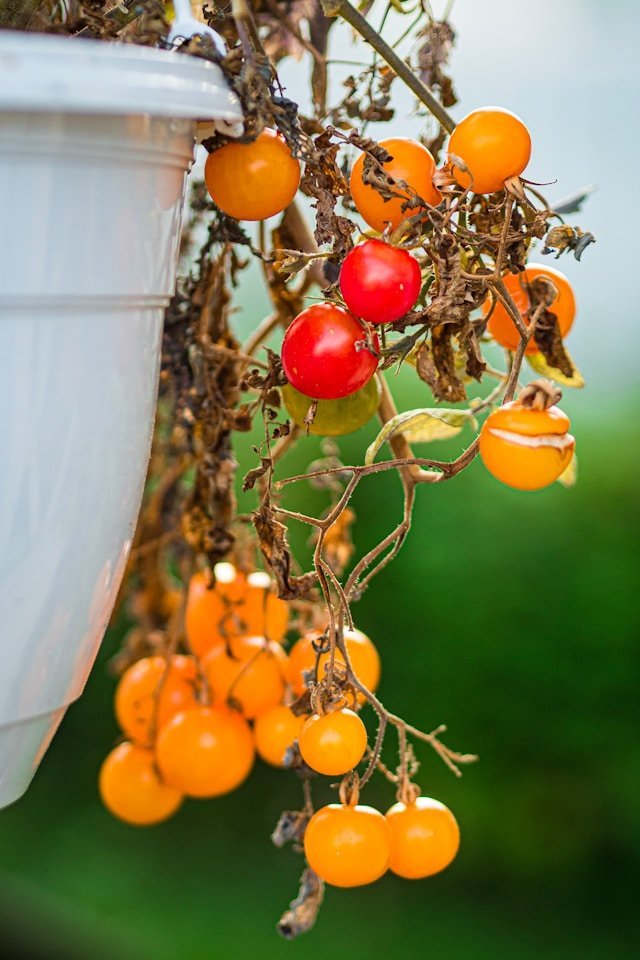
Tiny Troublemakers: Unveiling Spider Mites and Other Pesky Culprits of Browning Leaves
While we’ve explored diseases, pests can be another culprit behind browning tomato leaves. Pests like spider mites exemplify the challenges of growing healthy plants. These tiny terrors voraciously consume plant sap, leaving behind a path of destruction that’s hard to ignore.
Spider Mite Mayhem:
· Symptoms: Vigilance is vital when maintaining healthy garden soil, as evidenced by the need to watch for small, yellow, or brown spots on foliage, accompanied by delicate webbing on the undersides of leaves. If an infestation escalates, leaves may become entirely brown and detach, significantly weakening the plant.
Combating the Mite Menace:
· Early Detection is Key: Regularly inspect your plants for signs of damage and webs.
· Humidity Hinders Mites: Spider mites thrive in hot, dry environments. To combat these conditions and discourage mite infestations, increase the humidity around your plants by misting them or utilizing a humidifier to counteract the effects of dry air.
· Nature’s Helping Hand: To maintain good health in your garden, introduce or encourage natural predators such as ladybugs and lacewings. These allies can help control the spider mite population organically, promoting a balanced ecosystem.
· Safer Solutions: Consider using organic methods like insecticidal soaps or horticultural oils for heavier infestations. These treatments are less harmful to beneficial insects and the environment than traditional pesticides, offering a safer alternative for pest management.
Beyond Spider Mites:
While spider mites are common, garden pests such as aphids, whiteflies, and tomato hornworms can also lead to browning leaves and distress in your plants, signalling the need for vigilant garden care.
Controlling All Pests:
The key to healthy tomato plants is effective pest management. Similar to managing spider mites, you can achieve this through:
· Monitoring: Regularly check your plants for signs of trouble.
· Beneficial Friends: Promote natural predators to create a balanced ecosystem in your garden.
· Non-toxic treatments: Utilize natural or organic solutions when necessary.
By being proactive and utilizing adequate plant food and pest management methods, you can keep garden pests at bay, ensuring that your tomato plants remain healthy and productive throughout the growing season.

Specific Symptoms and Their Solutions
Tomato plant browning leaves can be a gardener’s nightmare. But fear not! This section delves into the key reasons behind this common garden care issue, providing actionable solutions to revive your plants.
Understanding the Symptoms:
- Browning From The Bottom Up:
This often points to early blight. Consider the impact of leaf diseases, such as early blight, a fungal disease that thrives in damp conditions. It typically starts on lower leaves, causing yellowing, browning, and eventually significant leaf damage.
· Brown Spots: These spots can signal various problems, including fungal diseases like septoria leaf spot and bacterial infections like bacterial spotLeaf spots, typically manifested as small to medium brown patches with a yellow halo on foliage, are common indicators of plant diseases.
Taking Action:
· Early Blight:
Improve Airflow & Drainage: Ensure good plant spacing and well-draining soil to prevent moisture build-up.
o Mulching: Apply mulch to reduce fungal spore spread through water splash.
o Fungicides (Severe Cases): Use a fungicide specifically for early blight, following application instructions carefully.
· Brown Spots:
Remove Infected Leaves: Promptly remove and destroy infected leaves to prevent further disease spread.
Watering Practices: Water at the base of the plant to minimize moisture on leaves.
Disease-Resistant Varieties: Opt for tomato varieties that are resistant to these diseases whenever possible.
General Solutions for Brown Leaves:
· Watering: To maintain an optimal watering schedule, ensure proper hydration of your plants with about 1 inch of water per week. Employ drip irrigation or water at the plant’s base to keep the foliage dry and healthy.
· Nutrients: Address any nutrient deficiency effectively by conducting a soil test to pinpoint specific needs. Subsequently, a balanced fertilizer should be applied according to the test results.
· Disease Management: To treat diseases that cause brown leaves, promptly remove the affected foliage and consider using fungicides if necessary. Additionally, implement crop rotation and uphold excellent garden hygiene to avert future disease outbreaks.
Combat plant stress by recognizing specific symptoms and implementing targeted solutions to rejuvenate your tomato plants, paving the way for a thriving and abundant harvest. While this guide addresses early blight and brown spots, seeking further information on diseases like late blight or verticillium wilt from additional resources is advisable.
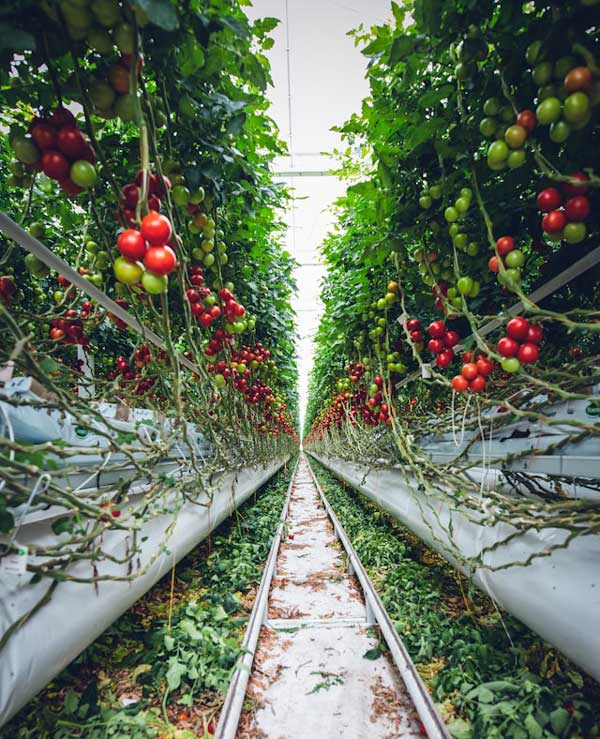
Stopping Browning Before It Starts: Preventive Measures for Healthy Tomatoes
Browning leaves can be disheartening for gardeners, but fear not. This section is dedicated to garden care, focusing on preventative strategies to ensure your tomato plants remain vibrant and flourishing throughout the growing season.
Guarding Against Disease:
· Crop Rotation: Interrupt disease cycles and enhance garden care by practicing crop rotation planting tomatoes in new locations annually to minimize the risk of soil-borne pathogens.
· Disease-Resistant Varieties: Select the best tomatoes by opting for varieties specifically bred to resist common diseases such as early and late blight, thereby outsmarting potential problems.
Watering Wisely:
· Water at the Base: To minimize the risk of fungal diseases, avoid overhead watering that can leave foliage damp; instead, direct water to the base of the plant to keep the leaves dry and healthy.
· Consistent Watering: Ensuring a consistent water supply is crucial for tomato plants, as it helps prevent stress that can leave them more susceptible to diseases and pests.
Cultivation Techniques for Success:
· Pruning: Boost air circulation by regularly pruning diseased or overcrowded branches, which can improve the plant canopy’s environment, thus reducing humidity and the risk of fungal diseases.
· Mulching: Practicing mulching around your tomato plants is beneficial as it maintains consistent soil moisture and temperature, curtails weed growth, and shields the foliage from soil-borne diseases during watering or rain.
By incorporating preventative measures into your gardening routine, you can significantly reduce the chances of browning leaves and ensure your tomato plants thrive. However, it’s important to remember that early detection and prompt treatment of issues are critical. So, if problems like early blight, brown spots, or nutrient deficiencies arise, refer to earlier advice for specific solutions.

Level Up Your Tomato Care: Advanced Strategies to Prevent Browning
Having explored the fundamentals of preventing browning leaves in tomato plants, we now focus on advanced gardening strategies for unparalleled tomato care.
Nourishing Your Plants for Success:
· Nutrient Powerhouse: Ensuring your tomato plants receive balanced nutrients is crucial for their health and productivity. Without them, you might notice browning leaves, decreased fruit yield, and heightened disease susceptibility.
o Soil Testing: Embarking on your planting journey, it’s wise to perform a soil test to gauge your soil’s nutrient levels and pH, which will inform your fertilization strategy.
Targeted Fertilization: Adopt a fertilization strategy tailored to your soil test findings, applying a balanced fertilizer to correct any deficiencies and promote the availability of essential nutrients.
o Organic Boost: Incorporate organic matter like compost to improve soil health and nutrient absorption.
Building a Disease-Resistant Garden:
· Crop Rotation Power: Practice crop rotation by planting tomatoes in a different location each year. Practicing crop rotation is a strategic move that interrupts the life cycles of soil-borne diseases, thereby reducing their potential impact on your future harvests.
· Garden Hygiene Matters: Maintain good garden hygiene to prevent disease and pest spread.
Clean Up: To uphold garden hygiene, clearing away plant debris at the season’s end is essential, as it can become a haven for diseases and pests during winter.
Sanitize Tools: One of the critical practices in garden maintenance is regularly sanitizing gardening tools, which helps prevent the spread of pathogens across your plants.
Brown Leaves on Tomato Plants Conclusion
By adopting these advanced strategies, including consistent garden hygiene, you’ll be well on your way to enhancing the health and yield of your tomato plants. Focusing on optimal nutrition and cleanliness paves the way for a robust and fruitful garden, keeping issues tomato plant browning leaves at bay. While this guide zeroes in on browning leaves, don’t forget to consult earlier sections for remedies to specific ailments such as early blight and brown rot.
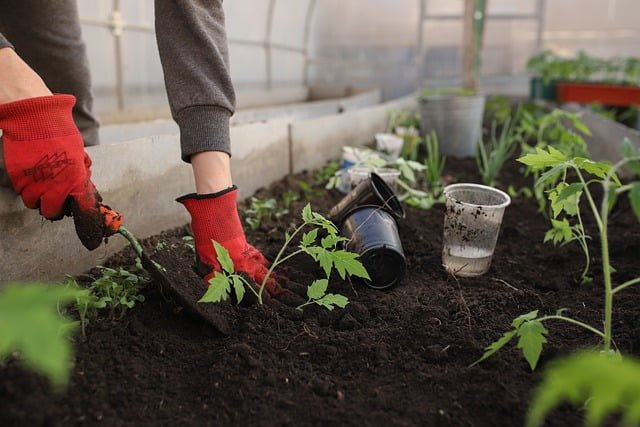
Tomato Plant Browning Leaves Q&A
Q: Why are my tomato plant leaves turning brown and curling?
Environmental stress, such as extreme temperatures or water scarcity, can cause leaves to turn brown and curl. This common issue may also stem from diseases like tomato blight. To mitigate environmental stress, ensure your plants receive sufficient water and are shielded from harsh weather conditions.
Q: How can I fix brown leaves on my tomato plants?
To address the issue of brown leaves, it’s crucial to take corrective action by refining watering habits, providing balanced nutrition, and treating plant diseases or pests. It’s essential to regularly inspect your plants for signs of distress and respond swiftly with corrective action.
Q: What causes tomato plants to turn brown from the bottom up?
Brown and curled leaves are often symptomatic of fungal diseases, including early blight. To combat these fungal diseases, enhance air circulation, lay mulch to avert soil splash, and consider the application of fungicides for effective management.
Q: How can I prevent tomato blight and other diseases?
To prevent diseases in your garden, adopt strategies such as crop rotation, selecting disease-resistant plant varieties, and upholding excellent garden hygiene. These practices are instrumental in reducing the likelihood of pathogens that could prevent diseases from impacting your plants.
Q: What are some effective watering practices for healthy tomato plants?
Effective watering practices, like irrigating plants at their base to keep foliage dry, are essential in reducing disease risk. Ensuring a consistent water supply, approximately 1 inch per week, is critical to averting plant stress and fostering robust growth.
Q: How can I optimize tomato plant nutrition?
Initiating a soil test to pinpoint nutrient deficiencies is a wise move toward enhancing soil health. Following the test, apply a balanced fertilizer tailored to the results and enrich the soil with organic matter, such as compost, to boost soil health.
Q: What cultivation and care techniques can help avoid browning leaves?
Implementing techniques like pruning to boost air circulation, mulching to preserve soil moisture, and ensuring proper spacing to avoid overcrowding are all adequate measures for maintaining tomato plants’ health and preventing leaf browning.
Q: Can implementing crop rotation and other cultural practices prevent fungal and bacterial diseases?
A: Indeed, implementing crop rotation is a strategic approach that disrupts the cycle of soil-borne diseases, while good garden hygiene, including the cleanup of plant debris and sanitizing gardening tools, is essential in preventing the spread of pathogens.
By tackling these questions and concerns with informed, proactive measures, gardeners are set to nurture healthier tomato plants and reap a more bountiful harvest. The cornerstone of flourishing tomato gardening is vigilant care and preventive strategies.
Find Best Companion Plants with Tomato
For further exploration of gardening articles, kindly visit our webpage: Home Garden
17 Fastest Growing Cactus Species for Your Thriving Garden
Poa Annua vs Crabgrass Invaders in Your Lawn (Identification & Control Guide)
Red Creeping Thyme Texas Tough & Fragrant Groundcover (Fast-Growing!)

